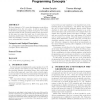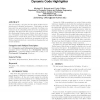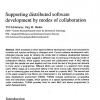105 search results - page 2 / 21 » Introducing concurrency in CS 1 |
OOPSLA
2004
Springer
13 years 11 months ago
2004
Springer
We have designed a CS 1 course that integrates event-driven programming from the very start. In [2] we argued that event-driven programming is simple enough for CS 1 when introduc...
SIGCSE
2009
ACM
14 years 6 months ago
2009
ACM
Like a screenplay, a program is both a static artifact and instructions for a dynamic performance. This duality can keep laypeople from appreciating the complexity of software sys...
CORR
2011
Springer
13 years 1 months ago
2011
Springer
The Compressive Sensing (CS) framework aims to ease the burden on analog-to-digital converters (ADCs) by reducing the sampling rate required to acquire and stably recover sparse s...
GLVLSI
2011
IEEE
12 years 9 months ago
2011
IEEE
This paper proposes a novel L1 data cache design with dualversioning SRAM cells (dvSRAM) for chip multi-processors (CMP) that implement optimistic concurrency proposals. In this n...
ECSCW
2001
13 years 7 months ago
2001
Work processes in team based software development need to be structured to minimise and resolve conflicting or divergent work. Current software development methodologies propose wa...



